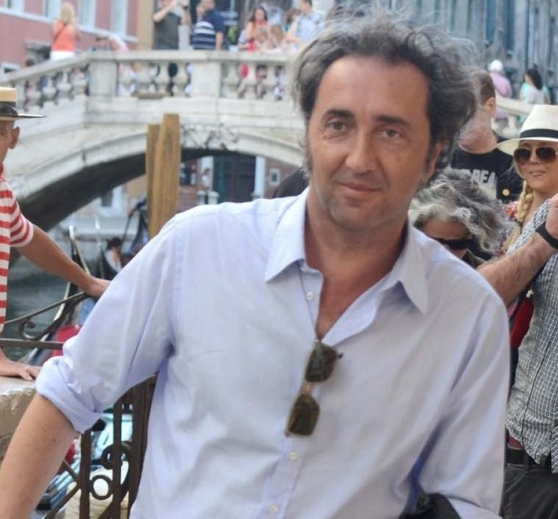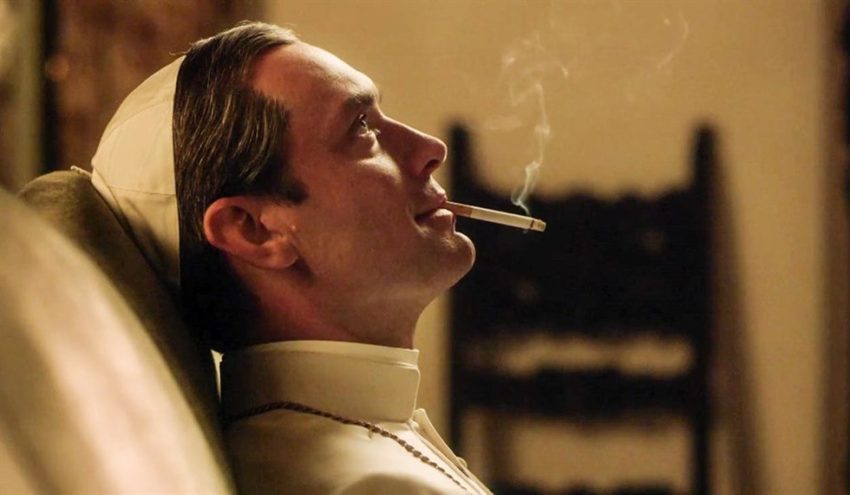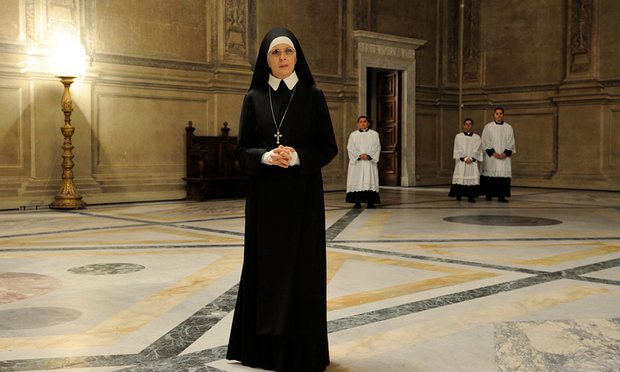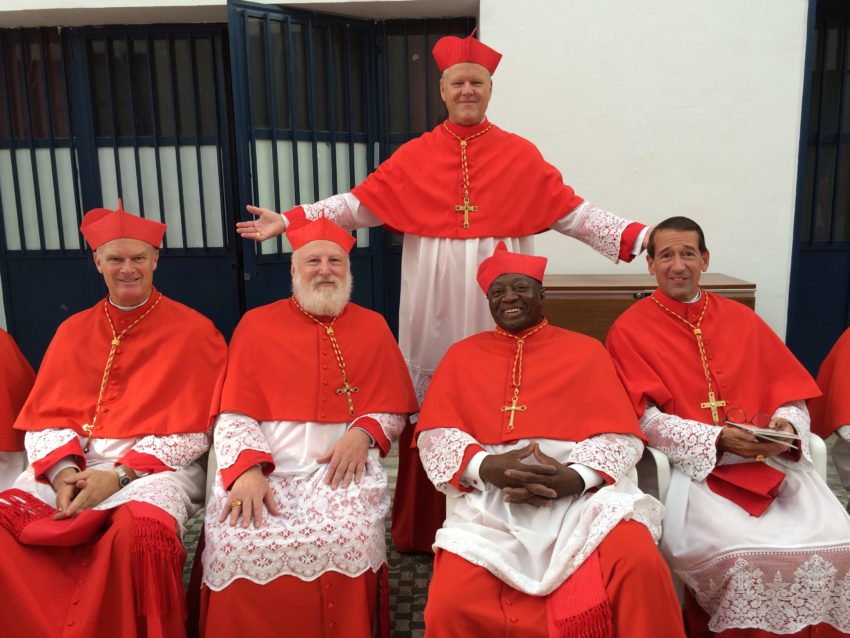Playing an extra in “The Young Pope” teaches me the cardinal rules of film business

(This is the first of a three-part blog on my participation as an extra in “The Young Pope,” the 10-part cable TV series starring Jude Law and Diane Keaton. It opened Friday in Italy on Sky Atlantic and this week in France, United Kingdom, Sweden and Poland on Canal+, C More and HBO. It begins in the United States on HBO Jan. 15.)
“CUT!”
It’s the voice of Paolo Sorrentino. The Oscar-winning director is wearing baggy gray pants, sneakers and a floppy, untucked shirt. His hair is curly and unkempt. So are his sideburns. He looks like Rick Reilly if the famous sportswriter ever went on a three-day binge. Sorrentino is the man credited with reviving Italy’s dormant film industry. He’s been called the next Fellini. He directed “The Great Beauty,” winning the 2014 Academy Award for Best Foreign Language Film, and the critically acclaimed “Youth” starring Michael Caine. His directing of “The Young Pope,” HBO’s 10-part series starring Jude Law as the first American pope with Diane Keaton as the nun advising him, moved Variety to say it’ll be America’s next big hit.
And right now, Paolo Sorrentino is pointing at me.
What’d I do? I’m only an extra. I play an American cardinal, one of the many nameless bodies that form a fluid red or black background as Jude Law maneuvers through scenes. We’re shooting a breakfast scene and I’m sitting two chairs down from a cardinal who’s about to die. My job is to eat slowly, look over calmly and appear expressionless as the cardinal falls to the floor. But did I eat too many grapes? Could Sorrentino tell I was choking? I KNEW I should’ve eaten the breakfast roll!

The assistant director comes over.
“Since you’re so close, when Paolo yells his name, ‘SAMBA!,’ you look over,” he tells me. “Don’t wait. When he yells, ‘MORTO!’ (DEATH!), that’s when the others look.”
Meanwhile, makeup artists carrying cases the size of the backpack I once used trekking in Slovakia, scrape porridge off the old cardinal’s face. Others dab sweat off the fat cardinals’ brows. More pineapple juice is poured.
We do another take. I drink some pineapple juice. I pop a couple of grapes. I pick up the biscuit a little early. I don’t want to appear as if I’m fumbling for food when this guy crokes. I hear “SAMBA!” I look over, trying to think of something emotionless, like a zip-code directory or my last Internet date. The scene ends.
“CUT!”
The assistant director makes a beeline toward me. Maybe I had honey dripping off a lip.
“You were good,” he says. “I watched you the whole time.”
I then contemplate what I’d wear to the Emmys.
***
My acting career began in the summer of 2015. I was doing my morning emails when I came across one from something called Wildside Studios. It’s a production company here in Rome and they said Paolo Sorrentino — THE Paolo Sorrentino — is making a film about an American pope. He needs American cardinals as extras. In other words, he needs tall Americans. An associate approached InterNations, a highly popular Meetup group of expats, and asked if they could recommend anyone. I’m 6-foot-3. I’m American. I qualify. It doesn’t matter that the only acting I’ve done has been on occasional dates. InterNations recommended me. The email asked if I’m interested, come to the studio offices. I went to the office in a building on a leafy, upscale street north of the Vatican. My casting call lasted all of five seconds — or about the time it took to walk through the door.

“You’re perfect,” the assistant casting director said before I even shook her hand.
I’ve been told I look as American as a Chevrolet commercial. Italians who can speak English address me in English before I open my mouth. This is the first time my face was ever an advantage in Rome. It got me a job. Well, a job in time only. My visa won’t allow me to get paid a dime for this experience. Italian Immigration bureaucracy is more difficult to negotiate than the Mediterranean waters desperate African immigrants cross to get here. I don’t care. Being retired in Rome is all about experiences; it’s not about money.

At least I got a free haircut out of the deal.
My scene is shot at Sant’Anselmo all’Aventino, a beautiful neo-romanic church on Aventine Hill where the Ancient Roman aristocracy lived. It was built in 1900 which, in Rome, means it just recently had its open house. It’s conveniently located up the windy, exclusive, larcenously expensive Aventine Hill from my apartment in modest, working-class Testaccio. One fellow extra drove four hours to get here; I walked 15 minutes.
I arrive at 9:15 a.m. for a 10:15 start and immediately get sent off to my first order of business. A haircut. I am told no cardinal has hair billowing out from behind his ears and down his neck. So I climb the stairs to one of the church’s offices and sit down with a flitting Italian hairdresser. He’s short, trim with short hair and a white T-shirt emblazoned with Jim Morrison wearing a red clown nose and the words “Life is a Circus.” We do the usual chit chat you have with a new barber. Where are you from? How long have you been in Rome? Doesn’t this summer’s heat suck? Meanwhile, the trim in the back turned into a full-scale clearout of the north wall.
“This is getting awfully short,” I say in English.
“Don’t worry,” he says. “You’re still sexy.”
I say nothing for a few minutes. I’m not homophobic but the conversation turns weird.
“So do you have a girlfriend?” he asks.
“Yes.”
“You should have someone like me,” he says.
Huh? I nearly turn around with his scissors sticking in my ear.
“Sorry,” I say. “I’m not gay.”
“No. I mean you should have a girl like me, someone who just wants sex. I know you’re not gay.”
“It’s more than sex with us.”
He does give me a good haircut and, fortunately, nothing else. However, I haven’t had hair this short since the seventh grade. He also puts so much spray on it, my hair feels like cotton candy. However, I can at least put on my red cardinal skull cap without it sitting aloft like a little satellite dish.
I then go to wardrobe where I have two people dress me. We have two uniforms: One, a bright red robe with a ruffly white frock that contains four layers and weighs more and is hotter than chainmail from the Middle Ages; two, a black one with red trim that’s actually quite comfortable and looks very sharp. It also has 22 buttons and stretches to the top of my shoes. I must pull it up like an evening gown to negotiate stairs. As we finish dressing, we go to a long, vacant hallway and take cell phone photos. I look at my frames. I barely recognize myself, merely because I’m wearing a cross for the first time in my life. With my white clerical collar, billowing black gown, bright red sash and barely a hair showing from under a red skull cap, I look as pure as new fallen snow.
As the other cardinals get dressed, we take seats and wait. And wait. And wait. A timed light keeps going out every 15 minutes, a blinking measuring stick for 24 strangers dressed like holy men to get acquainted. Thirty minutes later, I’m bored, sitting on a plastic chair deep in a sexual fantasy that would’ve embarrassed some of the emperors who once fornicated on these same grounds. Then I open my eyes and see I’m a cardinal. I say to myself, “Oh, mamma mia! If I’m not smote into a pile of dust, it is proof that God does not exist.”

Sorrentino wants us to be representative of the Vatican’s College of Cardinals so he has a cross section of the world. Among us are three dark-skinned black cardinals from Africa, a light-skinned black from Eritrea, an Asian, some very old, white-haired Italian men and a German guy named Edward who stands about 6-foot-5. I was the, quote, tall American. In Italian I ask one of the African guys speaking fluent Italian, a big burly guy with a round happy face, where he’s from.
“Gli Stati Uniti,” he says.
Charles is from Greensboro, Ala. He grew up during segregation so he had a few stories to tell. He’d been to Selma. He met Martin Luther King. He remembered George Wallace speeches. Charles moved to Rome 40 years ago as a musician and has played all over Europe. He’d just arrived from Puglia, the heel of Italy’s boot, where he was playing a gig and staying, ironically, in a seminary. We have a great talk about racism, Italy and American wars. He served during the Vietnam War but was lucky enough never to leave the U.S. We debated what was worse, the Iraqi or the Vietnam War. It’s like deciding between Stalin and Hitler. Of course, I go on my usual rant.
“THAT MOTHERFUCKING GEORGE BUSH! I’D LIKE TO STICK THE WASHINGTON MONUMENT RIGHT UP HIS FUCKING ASS!”
Now try to imagine that rant from a guy wearing cardinal robes. I rub my sleeves checking for rising heat. I can imagine myself suddenly bursting into flames.
We are two of four Americans. The others are Jeff, a clean-shaven, blond Air Force Academy grad who works for NATO, and a big, ruddy-faced guy from Chicago with a beard like Santa Claus. John moved to Rome three months before I did, in October 2013, when he married an Italian woman he knew in high school. He lives just down the street from me on Via Marmorata, Testaccio’s main drag. He plays the Scottish cardinal which will be a mean trick because he has no Scottish accent. A meaner trick will be the three-minute speech he must give in Latin.
I say a prayer for him.
We sit down at 10:15 a.m. At 3:15, after a decent boxed lunch of rice and pasta, we are all herded upstairs into a Sant’Anselmo’s huge conference room. The size of a small gymnasium, it’s filled with tables set for breakfast. Bowls filled with fruit, honey and butter, pitchers of tea, milk and pineapple juice, baskets of bread and biscuits. We’re all placed evenly apart, about two cardinals per table. The African guy next to me looks old enough to die. That’s when the makeup department earned all new respect because that’s exactly what he’s about to do.
A tall, bald, Italian assistant director gathers us and tells us the scene. We are having breakfast. In silence. No one is to talk. We’re not even to rattle silverware. Suddenly, one of the cardinals — the African guy at my table — dies of an apparent heart attack. We are supposed to slowly look over, stare for a few moments and then slowly turn back. Act as if it happens all the time in the College of Cardinals.
A gaggle of assistants preps the African guy on how to die. They give him the option of face planting himself in the porridge, or gasp and fall off his chair as if shot by a sniper. The assistant director comes up to me and in Italian says, “You’re the closest to him. Be sure to turn slowly toward him. Do not get excited.” I have him repeat it in English. My Italian comprehension still isn’t fluent. I don’t want to misunderstand the instructions and garrote the African with my red sash.
I’ve always had more respect for acting than about any profession. Memorizing lines and delivering with the accent and facial expressions on just the right syllables for emphasis is beyond difficult. I love the theater. On stage, they are naked. They can’t flub a line. The ovation at the end of the show will be their first review. After this scene, my respect for actors leaps over firemen and deep-sea oil well repairmen.
Eating fruit and slowly looking to your right doesn’t sound hard, does it? Do it while a voice in the back of your head keeps saying that several million HBO viewers will be looking at you. Right now. Should I chew a grape when I look? Should I hold a biscuit? Should I drink something? Indecision poleaxes me. A stage hand yells, “PRONTI!” (READY!) and I begin to panic. I have no plan for my biscuit, my “look!” Then I hear it.
“AZIONE!” (ACTION!)
Silence. I start feeding myself grapes like they’re M&Ms. I wait to hear a groan to my right, my cue to look over, passionless and cold. I do passionless and cold well. I’m a journalist. I decide on impulse that holding a biscuit covered in honey would be my best prop. I know this, of course, is my big break. A fumbled breakfast roll could ruin a promising career. I might never work again in this town. I see the African guy fall face first in his plate, keels to his right and falls off the chair. A thud comes up from the floor. I don’t move. I don’t raise an eyebrow which is harder than you think, especially since pineapple juice went down the wrong tube and I feel a need to spit up my left lung. I just sit there with my honey-covered biscuit a few inches from my quivering mouth. A couple seconds pass then behind me I hear John yell, “ED-GAR!” and slams the table.
We do two more takes before Sorrentino yells “BUONO!” He seems happy. At least he has stopped the nervous agitation, the scraping of his scalp I always imagine directors do when plowing through a scene. He smiles. He jokes. He seems like a guy I could have a glass of Barolo with. His attention to detail is stunning. He notices one cardinal didn’t turn his shoulder quite enough to look at the dying man. He makes sure John hits the table with just the right emphasis when he sees his fellow cardinal die.
This scene takes nine hours.
Afterward, I am moved outside to make way for a camera boom that looks like a miniature version of the cranes that built the Empire State Building. I meet some of the folks behind the scenes. Giorgia is the charming Italian assistant casting director who worked so hard but unsuccessfully to get me some kind of visa to allow payment. Anna is a cute Dublin woman who they call on the movie set a “cheek.” “I’m cheeky,” she said. “I wink and get Sean Penn (from another Sorrentino film, “This Must be the Place,”) to his scene.” I meet the head of the extras, Alessandra, a thin woman with no makeup and a head full of floppy black curls. She’s nervous and intense but encouraging and smiling.
It’s a good group. I make arrangements for a group shot at the end of our last shooting. We’ll all gather in our long flowing red ropes with frilly white tops and point at the cameras.
All with bottles of Peroni in our hands.


October 24, 2016 @ 11:27 pm
Well done! An enjoyable read. I look forward to the other two part.
October 25, 2016 @ 12:50 am
Thanks, Jake. Unfortunately, I’m just a red blur in the first two episodes. I think I’ll be seen in Episode 3 Friday.
John
October 25, 2016 @ 8:51 am
What an interesting adventure! Did you get any “behind the scenes” Vatican tours?
October 26, 2016 @ 1:09 am
Charlene: No Vatican tours. The Vatican didn’t help the producers one iota. We shot nothing at the Vatican. The Vatican scenes you see were built at Cinecitta.
October 25, 2016 @ 11:53 pm
I will wait to watch in English in the U.S., but how fun it will be to know a bit about the background and your role. Bravo!
October 26, 2016 @ 1:07 am
Thanks. I think I’m in three more scenes — at least, I’m filmed in three. I was left on the cutting room floor unless you count a fuzzy, tall, red image in the background a TV appearance. I should be in one of the first scenes Friday, Episode 3.
March 4, 2017 @ 8:12 am
Thank you for taking the time and effort to detail your experience. I thoroughly enjoyed living through your eyes.
Now, when I re-watch the series, I will be looking for you!
Maybe you can answer a question: when all the Cardinals are together wearing red, why is one guy all in black?
March 5, 2017 @ 4:40 am
Karen: You’ll have to look REAL close to find me. I’m in Episode 1 when Jude Law weaves his way through the ballroom of cardinals. I’m a blur he approaches near the start of the scene.
Good question on the man in black. We wondered the same thing but Paolo Sorrentino didn’t say too much. We were told the man in black was from India which deserved some special recognition. The extra really was Indian and that robe and turban were extraordinarily hot, he told us. He was the same Indian who tried telling Paolo that he’s a hero to a famous director in India and Paolo cut him off before he could explain. The extra then muttered some profanity in Hindu and took his place on the floor again. (A little behind-the-scenes insight, that.)
John